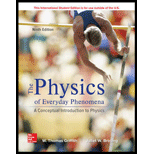
Concept explainers
(a)
The energy required to ionize a hydrogen atom in its lowest energy level.
(a)
Answer to Problem 3SP
The energy required to ionize a hydrogen atom in its lowest energy level is
Explanation of Solution
The energy level diagram of hydrogen proposed by the
Ionization energy is the energy required to remove an electron from its orbit. It will be equal to the negative of the energy of the electron in the orbit. The energy of the electron in the lowest level of hydrogen atom is
Conclusion:
Thus the energy required to ionize a hydrogen atom in its lowest energy level is
(b)
The energy required to ionize the hydrogen atom when it is in the first excited state above the lowest level.
(b)
Answer to Problem 3SP
The energy required to ionize the hydrogen atom when it is in the first excited state above the lowest level is
Explanation of Solution
The energy level diagram of hydrogen proposed by the Bohr model gives the energy of electrons in different orbits in hydrogen atom. The energy of a particular level in the hydrogen atom is given by the ratio of
The first excited state is the level which lies just above the ground level. The energy of the first excited state of hydrogen atom is
Ionization energy is the energy required to remove an electron from its orbit. It will be equal to the negative of the energy of the electron in the orbit. This implies the energy required to ionize the hydrogen atom in the first excited state will be equal to
Conclusion:
Thus the energy required to ionize the hydrogen atom when it is in the first excited state above the lowest level is
(c)
The wavelength of the photon emitted when an ionized hydrogen atom goes to the lowest energy level after capturing an electron with zero kinetic energy.
(c)
Answer to Problem 3SP
The wavelength of the photon emitted when an ionized hydrogen atom goes to the lowest energy level after capturing an electron with zero kinetic energy is
Explanation of Solution
An ionized hydrogen atom will have zero energy. The energy of the lowest level in the hydrogen atom is
Write the equation for the energy of the photon.
Here,
Substitute
Write the equation for the energy of a photon.
Here,
Rewrite the above equation for
The value of
Substitute
Conclusion:
Thus the wavelength of the photon emitted when an ionized hydrogen atom goes to the lowest energy level after capturing an electron with zero kinetic energy is
Want to see more full solutions like this?
Chapter 18 Solutions
Physics of Everyday Phenomena
- An ac series circuit consists of a voltage source of frequency 60 Hz and voltage amplitude V, a 505-Ω resistor, and a capacitor of capacitance 7.2 μF. What must be the source voltage amplitude V for the average electrical power consumed in the resistor to be 236 W? There is no inductance in the circuit.arrow_forwardAn L−R−C series circuit has R= 280 Ω . At the frequency of the source, the inductor has reactance XLL= 905 Ω and the capacitor has reactance XC= 485 Ω . The amplitude of the voltage across the inductor is 445 V . What is the amplitude of the voltage across the resistor and the capacitor? What is the voltage amplitude of the source? What is the rate at which the source is delivering electrical energy to the circuit?arrow_forwardA 0.185 H inductor is connected in series with a 98.5 Ω resistor and an ac source. The voltage across the inductor is vL=−(12.5V)sin[(476rad/s)t]vL. Derive an expression for the voltage vR across the resistor. Express your answer in terms of the variables L, R, VL (amplitude of the voltage across the inductor), ω, and t. What is vR at 2.13 ms ? Please explain all stepsarrow_forward
- A worker lifts a box under the following conditions:Horizontal distance (H): 30 cmInitial height (V): 60 cmVertical travel (D): 50 cmTorso rotation (A): 30°Frequency: 3 times/minute for 1 hourGrip: Good Question:What is the RWL for this task?What does this value mean in terms of occupational safety?arrow_forwardCan someone helparrow_forwardCan someone help mearrow_forward
- 3. Four identical small masses are connected in a flat perfect square. Rank the relative rotational inertias (IA, IB, IC) about the three axes of rotation shown. Axes A and B are in the plane of the square, and axis C is perpendicular to the plane, through mass m1. ΙΑ IB m2 m1 m3 Ic m4 (a) IAarrow_forwardConsider the circuit shown in the figure below. (Assume L = 5.20 m and R2 = 440 Ω.) (a) When the switch is in position a, for what value of R1 will the circuit have a time constant of 15.4 µs? (b) What is the current in the inductor at the instant the switch is thrown to position b?arrow_forwardCan someone helparrow_forwardCan someone help mearrow_forwardA particle in a box between x=0 and x=6 has the wavefunction Psi(x)=A sin(2πx). How muchenergy is required for the electron to make a transition to Psi(x)= A’ sin(7π x/3). Draw anapproximate graph for the wavefunction. Find A and A'arrow_forwardA proton is moving with 10^8 m/s speed. Find the De Broglie wavelength associated with theproton and the frequency of that wave.arrow_forwardarrow_back_iosSEE MORE QUESTIONSarrow_forward_ios

 College PhysicsPhysicsISBN:9781938168000Author:Paul Peter Urone, Roger HinrichsPublisher:OpenStax College
College PhysicsPhysicsISBN:9781938168000Author:Paul Peter Urone, Roger HinrichsPublisher:OpenStax College Glencoe Physics: Principles and Problems, Student...PhysicsISBN:9780078807213Author:Paul W. ZitzewitzPublisher:Glencoe/McGraw-Hill
Glencoe Physics: Principles and Problems, Student...PhysicsISBN:9780078807213Author:Paul W. ZitzewitzPublisher:Glencoe/McGraw-Hill College PhysicsPhysicsISBN:9781285737027Author:Raymond A. Serway, Chris VuillePublisher:Cengage Learning
College PhysicsPhysicsISBN:9781285737027Author:Raymond A. Serway, Chris VuillePublisher:Cengage Learning University Physics Volume 3PhysicsISBN:9781938168185Author:William Moebs, Jeff SannyPublisher:OpenStax
University Physics Volume 3PhysicsISBN:9781938168185Author:William Moebs, Jeff SannyPublisher:OpenStax An Introduction to Physical SciencePhysicsISBN:9781305079137Author:James Shipman, Jerry D. Wilson, Charles A. Higgins, Omar TorresPublisher:Cengage Learning
An Introduction to Physical SciencePhysicsISBN:9781305079137Author:James Shipman, Jerry D. Wilson, Charles A. Higgins, Omar TorresPublisher:Cengage Learning





